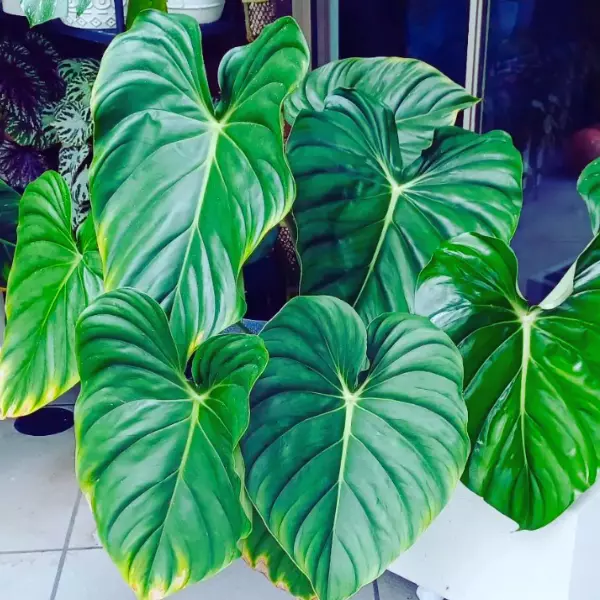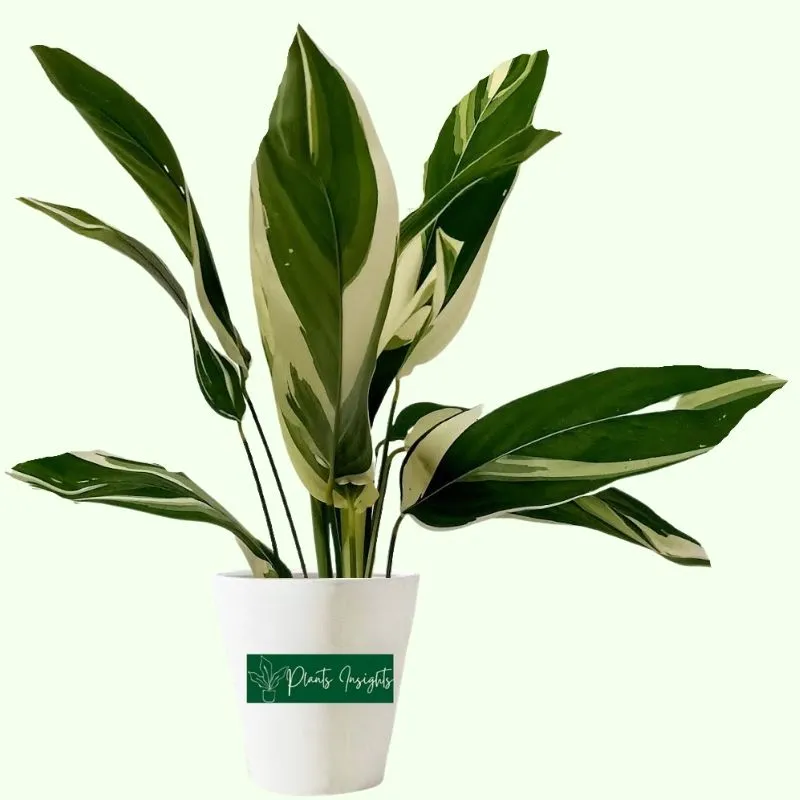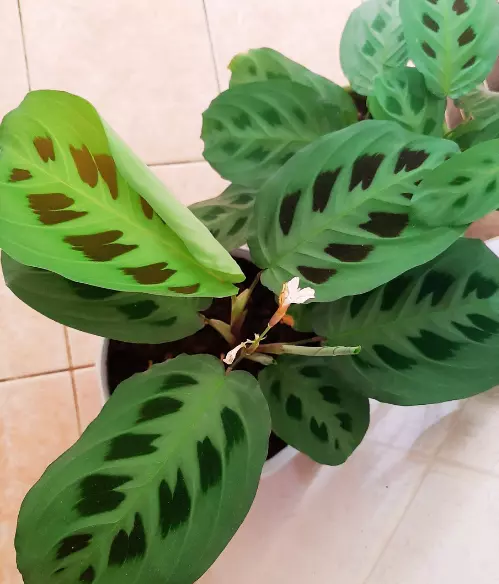Philodendron Pastazanum is an easy-to-care exotic plant with stunning heart-shaped foliage. Pastazanum features heart-shaped, glossy, ribbed dark green leaves, making it one of the most sought-after plants. This beautiful plant is a crawler, growing petioles vertically from the stem and carrying eye-catching leaves. This lovely perennial is known as the Pasta plant Philodendron and is fondly called “My Pasta” on social media..
Philodendron Pastazanum is a stunning plant with impeccably sized glossy leaves. It’s one of the easiest philodendron houseplants, which isn’t demanding, thus perfect for beginner plant parents.
Closely-Related Allied Species: Philodendron Brandtianum, Philodendron White Knight, Philodendron White Princess, Philodendron Moonlight, Philodendron Verrucosum, Philodendron Mamei, Philodendron Squamiferum
Essential Products
Origin and Family
Philodendron Pastazanum belongs to the Philodendron genus and the Araceae family. It is native to the tropical rainforests of Ecuador’s state called Pastaza and Peru and was first identified by Kurt Krause in the 1970s, the era of revival of the Victorian age. Many botanical explorations took place at that time.
| Botanical Name | Philodendron Pastazanum |
| Family Name | Araceae |
| Other names | Pasta Plant Philodendron, My Pasta |
| Plant Type | Perennial |
| Origin | Ecuador and Peru |
| Color | Glossy Dark green |
| Leaf Shape | large heart-shaped leaves |
| Height | Up to 3 to 5 feet tall |
| Humidity | 65% to 75% |
| Temperature: | 65°F to 85°F (18°C to 29°C) |
| Light Need | Bright Indirect light |
| Propagation | Stem cutting |
| Soil type | Coarser, lighter, well-drained, rich in organic matter |
| Status | Rare |
| Preferred PH | 5 to 7 |
How do you take care of Philodendron Pastazanum?
Pasta Philodendron thrives in a highly humid and warm environment. To keep it happy, you need to keep it in a place with ample indirect light and plant it in a well-draining, nutrient-rich potting soil. It also appreciates repotting once in 1 to 2 years.
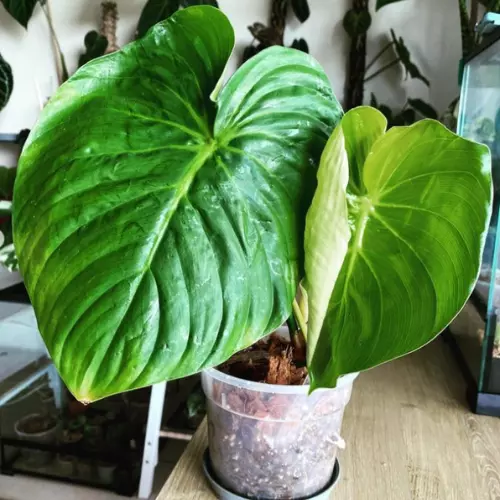
This article will explain every care aspect to keep this stunning houseplant happy and thriving with no fuss. So, without any further due, let’s get started.

What is a Philodendron Pastazanum plant?
Pasta plant is highly sought after for its large heart-shaped, quilted-looking leaves exhibiting the glossy medium green finish. It’s not uncommon for the leaves on a Pastazanum to grow as large as two feet in diameter and length.
Moreover, each leaf grows on a single elongated petiole growing on a crawling stem. The average height of the Pastazanum is only three to five feet, but it can spread to about six feet in width.
The growing season of pasta plants is in spring and summer. When it’s provided with a suitable environment, it helps speed up the growth.
How big does Pastazanum get?
Philodendron is a moderate grower and can reach a height of 3 to 5 feet and spread to a width of 4 to 6 feet when it matures. The growing season of pasta plants is spring and summer. When it’s provided with a suitable environment, it grows pretty quickly.
Is Philodendron Pastazanum a crawler or climber?
Unlike many Philodendrons, the Pastazanum is a crawler that grows horizontally along the soil surface rather than climbing up trees. The crawler stem should not be buried in the soil; instead, it should be left on the surface to avoid plant rot.
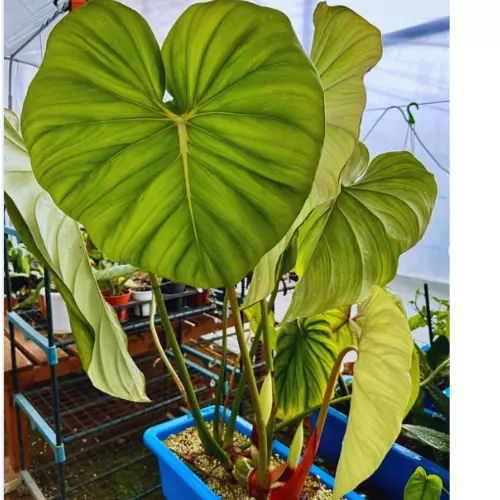
We recommend planting your Pasta plant in a rectangular pot to let the stem crawl along the potting mix. The aerial roots along the stem also absorb water and nutrients resulting in larger leaves.

Watering
Philodendrons enjoy the highly humid environment; hence, they need consistently moist soil but can’t tolerate overwatering. Watering this plant could be tricky; that’s why you should only water it when needed, and the common indication of watering it is when the top soil is dry. The watering needs vary from season to season as the plant’s water frequency increases in summers and reduces in winters.
As mentioned earlier, the pasta plant is intolerant to overwatering as it can severely damage the plant and can result in many infections and diseases such as root rot. Similarly, it doesn’t appreciate underwatering, which results in brown and crispy leaf tips and slow growth. Hence, it would be best if you were very careful with the watering frequency and only give it a drink when it wants.
The best way to determine the plant’s watering need is to check the dryness of the topsoil by dipping a finger in the potting soil. You can also determine the watering need by checking the pot size; if it feels lighter, your plant is thirsty.


Light Needs
As this plant is native to tropical regions, it appreciates and enjoys bright, indirect sunlight. Although it can also take a few hours of direct sun, and the morning sun is ideal, it should be kept in direct sun for a short time, especially the intense afternoon sunlight should be avoided as it can burn the plant.
The east-facing window is ideal as the plant can get a few hours of direct morning light and ample indirect light for the rest of the day.
It’s a delicate plant that can’t tolerate intense direct sunlight, which can cause leaf burn and other severe damage to the plant. In case you place your plant in south or west-facing windows, use sheer curtains to filter intense direct light during the day that may burn the foliage.
In contrast, low light is harmful and can result in stunted growth and smaller leaf size. Therefore, keep the plant at an appropriate location where it can get 6 to 8 hours of light daily.
Consider investing in LED grow lights in deficient natural sunlight to help the plant thrive. Without adequate light, the leaves of the Pasta Philodendron can turn pale and yellow, and the entire plant can become leggy. Also, direct bright sunlight can scorch its leaves. Therefore, it’s vital to ensure that the light is always optimal for the plant to promote healthy growth.

Humidity and Temperature
Pasta Aroid loves high humidity and thrives at 65% and above moisture levels. If you want to keep your plant healthy and happy, sustain the required moisture levels as this plant doesn’t progress in a low humid environment, which can cause many issues such as diminutive growth and brown leaf tips. Therefore, follow the tips below to increase your home’s moisture level.
Tips for increasing humidity
- Group your plants to create a microclimate to increase the humidity around plants as the plants release moisture through the transpiration process, which raises the moisture in the environment.
- Another way to increase the humidity for the plant is placing a humidifier in the room. A humidifier is a great way to increase the moisture level. Set the humidifier between 65% to 75% to attain the desired results.
- You can also mist the plant three to four times a day to increase the humidity level in the room, but misting is considered a temporary method; therefore, use a humidifier along with misting your plant.
- A Pebble tray is also a great way to increase the moisture level. Place a tray beneath the plant pot and fill it with water. The water will evaporate and increase the humidity around the plant.
Due to its tropical nature, the Pastazanum likes to be kept in a warm environment as it doesn’t enjoy low temperatures. The ideal temperature range for the plant is between 65°F to 85°F, but the plant can do well up to 55°F but can’t endure temperatures below this level.
Therefore, it’s recommended to keep it indoors in the fall when the temperature drops below 50F at night. This plant can’t withstand cold drafts; thus, avoid placing it near air conditioners in summer. Moreover, using heating pads and frost blankets during winter helps maintaining the optimal temperature.

Soil
The right potting mix is very critical for plant growth and health. The Pastazanum does best in neutral to slightly acidic (PH 5 to 7) soil, and it should also be well-draining and aerated for roots to breath. Moreover, the potting medium requires ingredients that can retain moisture as the plant fancy moist soil .
You can prepare your own nutrient rich soil mix by using the following components.
Six parts of Orchid bark: It is lightweight and improves aeration and drainage in the soil. It can also absorb the water, hold the nutrients, and slowly release them to the plant roots.
Four parts of Perlite: It’s an essential part of a healthy potting soil mixture for houseplants and is used worldwide by gardeners. It is lightweight and has porous characteristics that help loosen the soil and prevent it from getting soggy. It also improves drainage and retains moisture.
Some Sphagnum moss: It has anti-bacterial and anti-fungal properties. It can also retain the water and nutrients in the potting medium.
Two portions Pumice: It is PH neutral and helps the air to reach the roots, and its porous properties drain the excess water from the soil, thus preventing root rot.
Four parts Coco Coir: It is obtained from coconut husk and contains no diseases and viruses. It circulates the oxygen and helps it reach the roots; it has water retention properties and maintains the PH of the soil.
Worm castings: It helps increase soil’s water retention, improve soil aeration, and anchor plant nutrients that would otherwise leach away with water.
Besides that, you can also choose from our recommended potting mixes available on the market, such as:

Potting & Repotting
A thin and rectangular pot is appropriate for Pastazanum as its rhizomes grow linearly; therefore, a round and deep planter isn’t suitable for this plant. You can use clay, plastic, self-watering plant pots, and terracotta pots for growing the Pasta philodendron. Also, ensure the container has drainage holes to allow excess water to drain out.
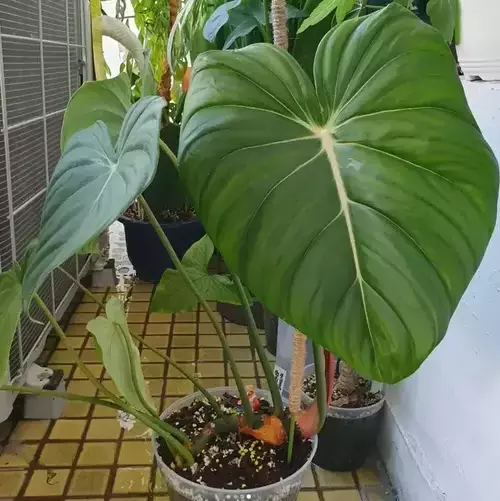
The plant needs fresh and nutrient-rich potting soil. You can use the soil recipe that is mentioned above.
Philodendron Pastazanum likes to be root-bound and doesn’t need repotting quite often, but it needs to be transplanted in a new container every one or two year.
The best time to transplant the plant is in spring or summer as it’s a growth season and may help to adjust the plant to a new place.
Signs of repotting
The common signs of repotting your beloved Pasta plant are
- The roots start peeking out of drainage holes.
- The roots begin to grow on the soil surface.
- The growth becomes stunted.
- The plant has some infections and diseases, such as root rot.
- The soil needs frequent watering.
Tips of repotting
Here are a few tips for repotting your plant.
- Always use at least one bigger container than the previous one to allow enough room for the roots to grow.
- Always use a fresh potting mix in the new container.
- The best time for repotting is the active growing season.
Steps of repotting
When you transplant the pasta plant, water it thoroughly at least 24 hours prior.
- Gently remove it from the container.
- Knock out excess soil around the roots.
- Inspect the roots for any infection or damage; in case of damage, remove the affected parts.
- Carefully put the plant in the new pot and fill it with fresh, nutrient-rich potting medium.
- Water it thoroughly afterward and place it in a bright location.
- You can add some slow-release fertilizer, such as osmocote, to boost the growth after repotting.

Philodendron Pastazanum Propagation
Philodendron Pastazanum can easily be propagated via stem cuttings and air layering with high success rate.
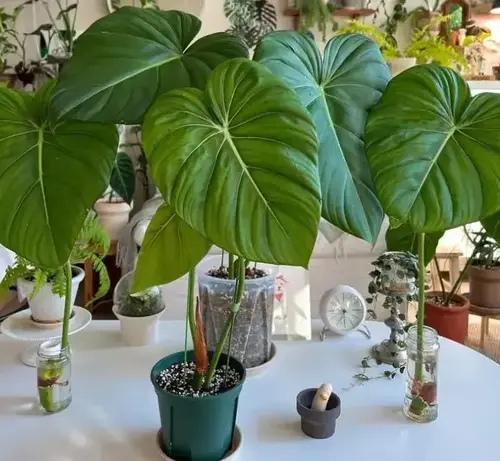
Stem Cutting Propagation
For this kind of a crawling Philodendron that has long internode we prefer stem-cutting propagation as this is simple and has a high success rate. As the leaves are enormous, single-node cuts are just fine for propagation.
Follow a step-by-step guide for Pasta Philodendron propagation via stem cutting.
Propagation in Water
For a Pastazanum’s cutting with very little roots, I usually put it in water because it does need to absorb more water to support the leaf and the new node.
Propagation in Sphagnum Moss and Potting soil
You can also use sphagnum moss and aroid potting mix for rooting your cuttings. I prefer using sphagnum moss for cuttings that have a little bit of roots and potting mix directly if they already have a lot of roots.
Before putting your cuttings in sphagnum moss or potting mix, you might need to seal the edge of your cutting by applying cinnamon powder, anti-fungal powder, or activated charcoal to prevent rotting.
Air Layering Propagation
Pasta Philodendron grows aerial roots along its stem and can be propagated using air layering method if you don’t want to cut your plant.

Fertilizing
Though the Philodendron Pastazanum is a houseplant, it also needs fertilizer in the growing season. In this season, the plant needs more nutrients, resulting in healthy foliage production and a robust rhizome.
The growing season is spring, and summer is when your plant needs more feed at least once a month. But when it comes to winter, it doesn’t need fertilizer because the growth slows down in colder months, and the plant enters dormancy.
A balanced all-purpose liquid fertilizers is ideal for this tropical houseplant. However, use it half in strength than the recommended amount and don’t over-fertilize it as it can cause the salts to build up in the soil, which can burn the plant.
If you are new to plant parenting I highly recommend trying Miracle-Grow Indoor Plant Food Spikes. These pellets are really easy to use and will not burn any foliage of your plant.
Here are some good fertilizers for your Philodendron available on the market:
- Philodendron Plant Food, Indoor Plant Food Liquid Fertilizer
- Liqui-Dirt Nano Powder All-Purpose Organic Plant Food
- Osmocote Smart-Release Plant Food
As a slow grower, Pasta plant requires regular fertilization, but it’s important to note that over-fertilization won’t speed up the growth but can harm Philodendron Pastazanum. Moreover, too much fertilizer can lead to the buildup of salts in the soil, which can damage the plant’s roots and cause leaf burn.

Pruning and Maintenance
The Philodendron Pastazanum is a naturally neat plant that grows slowly and doesn’t need pruning to maintain its shape. But it does need pruning to remove damaged or old leaves. Using sharp, sterilized shears to trim the yellow leaves would be best. Make a sharp cut at the end of the petioles where they meet the crawling stem of the plant.
Pruning can also stimulate new growth and branching, which can help keep your plant looking full and healthy. As the leaves of this plant are significant, if they grow too thick and bother each other, you can cut a few, as the dense leaves can hinder air circulation and encourage fungal development. Cutting them in advance can prevent future problems and boost healthy growth.

Toxicity
Pastazanum carries toxic calcium oxalate crystals for humans and pets like all other philodendrons. In case of ingestion, it can cause swelling in the mouth and digestive tract, inflammation, difficulty breathing, and nausea. This perennial aroid also causes skin irritation; therefore, always use gloves when handling it.

Pests
This aroid is prone to many pest infestations as it’s not pest-resistant. Some common pests that might attack your beautiful philodendron are
Mealybugs:
These tiny insects attack the plant stems and feed on the sap, which can weaken and kill your plant eventually. In case of mealybug invasion, take a cotton swab, dip it in rubbing alcohol, and gently wipe the leaves and stems. You can also use neem oil and water spray as a preventive measure for mealybugs.
Spider mites:
Spider mites are the most common problem of philodendrons, and they can damage the plant to a great extent. They cause webbing in the plant and also tiny yellow or brown blotches on the leaves. The spider mite incursion may slow down the growth, so it needs to be treated early.
To combat this problem, you can thoroughly wash the plant and drain the excess water completely. If this method doesn’t work, use insecticidal oils to treat spider mites.
Scale insects:
These are tiny brown, gray, and black bugs. They appear as a lump on the stems and branches. To deal with this problem, make a mixture by taking a tablespoon of neem oil in four cups of water and spraying the plant thoroughly.
Whiteflies:
The white flies are gnat-like pests that feed on the plant’s sap. The pasta plant leaves undersides are demolished by larvae that hatch from the eggs. Pesticides are commonly used to treat white flies as these pesticides can kill them at all development stages by stopping their growth.
Diseases
Like any other houseplant, Philodendron Pastazanum is also susceptible to many diseases, but the best part is that you can treat these diseases when caught in the early stages.
Root rot:
This is the most common problem of a houseplant and can kill the plant if it’s not treated on time. The primary cause of root rot is overwatering, when the plant gets more water than the required amount and drainage isn’t good.
As they say, prevention is always better than treatment, which is true in pasta plant care. For example, use a pot with proper drainage holes, use well-draining soil, and water the plant only when needed. By these preventive measures, you can avoid root rot.
The common signs of this disease are yellow leaves, mushy black roots, and soft stems. If you suspect your plant has root rot, remove it from the container and examine its roots. Remove the damaged parts and report it in a new pot with fresh potting mix. Place it at a sunny location and take care of water frequency.
Common Problems
The common problems that this delicate aroid may encounter are
Brown leaves:
If your plant’s leaves turn brown, especially the leaf tips, it indicates that the plant is getting too much sunlight or there is low humidity in the environment.
Yellow leaves:
Too many factors cause yellow leaves, such as too much or too little water and insufficient sunlight. In the case of yellow leaves, investigate the underlying reason and fix it accordingly.
Several factors, such as improper fertilization, poor drainage, overwatering, and mealybug invasion, can also cause drooping leaves. In that case, check the cause and adjust it on time.

Common Queries
Is Philodendron Pastazanum rare?
Philodendron Pastazanum is a highly sought-after heart-shaped Philodendron houseplant that is hard to find to get your hands on. However, it is not rare, as you can buy one from online plant stores.
Is Philodendron Pastazanum easy to grow?
The Pastazanum is one of the easiest houseplants to grow out of more than 480 species of philodendron genus. It’s not demanding at all and suitable for newbie plant enthusiasts.
Is Philodendron Pastazanum a crawler?
It is a crawler as the main stem grows horizontally along the surface of the potting mix. The petioles grow vertically and carry stunning leaves. It has a strong stem and doesn’t require a moss pole for support.
What is the difference between Pastazanum and Mcdowell?
The Mcdowell has reddish or pinkish leaf margins that are less glossy and velvety in texture, while Pastazanum has more glossy leaves. Also, Mcdowell has reddish cataphylls, while Pastazanum has more greenish ones.

Conclusion
Philodendron Pastazanum is an outstanding houseplant that can make any place worth living with its gorgeous appearance and easy-to-grow nature. This plant has attractive, glossy, shiny, heart-shaped leaves that grow vertically from the petioles.
Pasta plant isn’t fussy at all and requires low maintenance, making it suitable for beginner plant parents. If you are also an aroid lover, this plant will be a beautiful addition to your aroid collection.
Now my plant lovers get yours today and experience the unique beauty of this stunning plant.
Happy plant parenting!
Related Posts
Calathea Care Guide
Calathea plant care guide will help you grow them indoors as an ornamental plant because of its stunning foliage patterns.
Maranta Arundinacea Variegata Care Guide
A variant of Arrowroot called Maranta Arundinacea Variegata, with little care produces beautiful foliage and commercially beneficial roots.
Maranta Silver Band Grow and Care Guide
Maranta Leuconeura Silver Band is a darling of native Brazilian forest its broad silver band leave’s pattern makes plant more enchanting.
Best Grow Tent for Quality Grow
We have done close inspections and critical reviews of popular brands to provide you with the right inputs to select the best grow tent for quality grow.
Maranta Kerchoveana Prayer Plant Care Guide
With little care Maranata Leuconeura Kerchoveana or Green Stripe Prayer Plant displays stunning mint color foliage with dark green spots.

